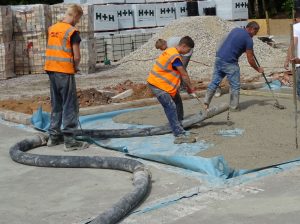There are a number of measures that must be taken to ensure safe and effective concrete pumping onsite, from wearing the correct protective clothing to checking that your mix is suitable for the project. Careful preparation should guarantee a successful job.

There are a couple of ways of combating the danger of concrete freezing. Perhaps the simplest method is to insulate the pipes and drums of the pump system. This could take the form of foam tubing covering the boom, maintaining a moderate temperature inside the equipment.
Another effective way of preventing the concrete from freezing solid is to ensure that the water used at the mixing stage is very hot, which should hopefully get the mix through the delivery period and into the pump before the cold temperature becomes an issue. Discussing this with your ready mixed concrete company before arranging delivery is advisable.
If the unfortunate occurs, and your mix does happen to freeze during pumping, turn off all machinery and allow it sufficient time to warm up and thaw before restarting, cleaning out all existing remnants of the original mix. Attempting to continue pumping with frozen concrete in the boom could damage equipment.
The risk of freezing isn’t over after the concrete has successfully left the pump, however. If the mix freezes before setting, it will not set correctly and may have to be re-laid. Any accelerators that might be added (such as calcium chloride) will help to encourage a quick setting time, but if the mix has to be warmed before pumping, this could occur too quickly. Timing could be crucial in this respect.
Health and safety procedures should be followed at all times when pumping concrete, with a few extra considerations when doing so in cold weather. Protective clothing – including hard hats, safety goggles, gloves, long-sleeved and legged clothes and robust footwear – should be worn at all times to protect skin and eyes from wet concrete, while a nominated and qualified supervisor should be in charge of boom movement at all times.
In cold temperatures, extra care should be taken when standing on pipework or the steps and platforms of machinery, as ice may have formed making the surfaces hazardous. Precautions should also be taken to ensure that the equipment being used, particularly the boom, can withstand sub-zero temperatures, and won’t become too brittle and crack when cold.
If you are expecting cold weather conditions during a period of construction, check with your concrete provider before ordering that they can mitigate for such temperatures. The experts at All Mix Concrete are on hand to offer advice and assistance for concrete pumping in freezing weather, so don’t hesitate to get in touch today to find out how we can help.





